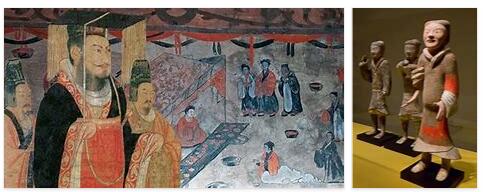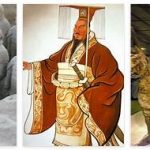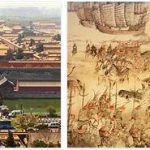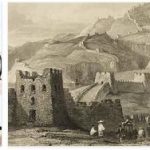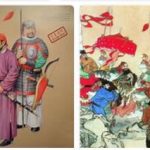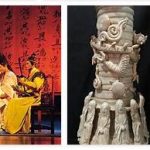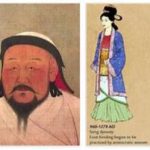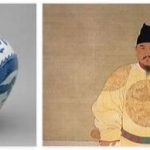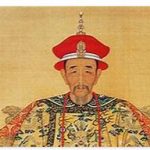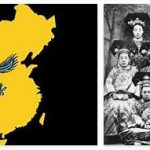125 BC The ambassador Zhang Qian (Chang Ch’ien), who had been sent to West Turkestan in search of allies against the Xiongnu, returned from the western people of the Yuezhi (Yüeh-chih, Chinese name of the Tocharer) and brought news to the imperial court for the first time from countries outside the Chinese cultural area. The armies soon followed the diplomat: East Turkestan was Chinese up to the Pamirs in 101. It was then that the Silk Road came into being. Other foreign policy successes of the emperor were the colonization of North Korea and the conquest of southwest China. It should be emphasized that despite the expansion of the empire during the entire Hanzeit, Chinese and non-Chinese lived together in many areas of the empire.
Wudi’s reign was part of a roughly hundred-year period in which many leitmotifs emerged that became characteristic of Chinese government action: from the primacy of politics (over the military and the clergy) to the way of organization (three top state offices, six ministries, one censor) to State examinations for candidates for civil servant posts and to justify a typical Confucian way of reasoning.
The poll tax was the main source of income for the state. The adult men were obliged to serve one month a year; For the 23 to 56 year olds, there was also two years of military service. The tax revenues were supplemented by the monopolies on salt, iron, for coinage, the production and sale of wine and for the use of mountains and marshes.
The establishment of a state university for the training of civil servants and the beginning of an “exam” for civil servant candidates had serious consequences for the further history of China. Under the mobile dynasty, however, the majority of civil servants still got into office through the right to propose their civil servant fathers or uncles. The basis of the teaching and examination content was now for the first time a Confucianism, in which the administrative art of legalism was combined with the human features of Confucian teaching. Additional attractiveness of Confucianism still won by the Daoism adopted Yin-Yang -Natural philosophy, with which the mutual influence of heaven and lifeworld is interpreted – and thus, among other things. a state oracle could also be operated.
The Confucian scholars are to be thanked for the restoration and transmission of the literature destroyed by the Qin. The first commentaries and dictionaries were the fruit of this activity. The first great historical work of China, the “Historical Records” (Shiji, Shih-chi) of Sima Qian, was also completed during the reign of Wudi. The custom of the emperors, finally introduced under Wudi in 114, of placing their rule under watchwords that banished happiness, was of longer lasting significance. The year count within these (initially) frequently changing government currencies (Motto) since then has also served to fix the time information; since the Ming the motto has been identical with the reign, so that it is also used as the name of the ruler.
After Wudi’s death, the financial crisis triggered by the numerous wars against the Xiongnu and the growing influence of the respective empress clans led to the coup of Wang Mang (* 45 BC, † 23 AD) in 9 AD., the nephew of an empress. Whose dynasty, whose name Xin (Hsin, “The New”, 9-23) is perhaps to be understood programmatically, but was perhaps also named after a former fiefdom, tried the state crisis with the romantic-reactionary recourse to the now under the influence of To solve Confucianism as the ideal transfigured order of the early Zhou period. But that failed because of the popular uprising of the “Red Eyebrows” in eastern China, a country located in Asia according to areacodesexplorer.com, the cause of which is probably the impoverishment of the masses as a result of floods, particularly through the relocation of the lower reaches of the Hwangho. This led inter alia. to huge population movements.
A member of a branch line of the emperor’s clan, Liu Xin (Liu Hsin), as Emperor Guangwudi (Kuang-wu-ti, 25–57), put the dynasty back in their rights in AD 25. Because of the relocation of the capital from Chang’an (now Xi’an) to Luoyang in the east, it is also called the Eastern Han dynasty (25–220 AD) in contrast to the earlier Western Han. In the first century of her rule she succeeded in regaining the territory lost under Wang Mang in the north and west and in expanding the empire further: the Xiongnu were subjugated again and East Turkestan was temporarily recaptured. In the south, Chinese colonists advanced as far as Tongking and Annam.
Domestically, the time of the Eastern Han was shaped by several peculiarities that weakened the central power: The social situation of the lower classes deteriorated, small farmers who sold their property lost their independence. Large latifundia ofrich landlords who forced small farmers to lease them were barely accessible to the tax authorities. Cliques for large families, clans of various empresses and eunuchs who had the right to adopt fought one another; Thousands were killed in brutal campaigns by eunuchs. In addition, most of the Eastern Han emperors were minors when they ascended the throne. The weakness of the dynasty was also due to military-political reasons: towards the end of the dynasty, the right to two years of military service for adult men could no longer be maintained, so that military power was increasingly privatized. Weakened in this way, the dynasty was confronted for the first time at the end of the 2nd century with the state-endangering potential of Chinese religions.
